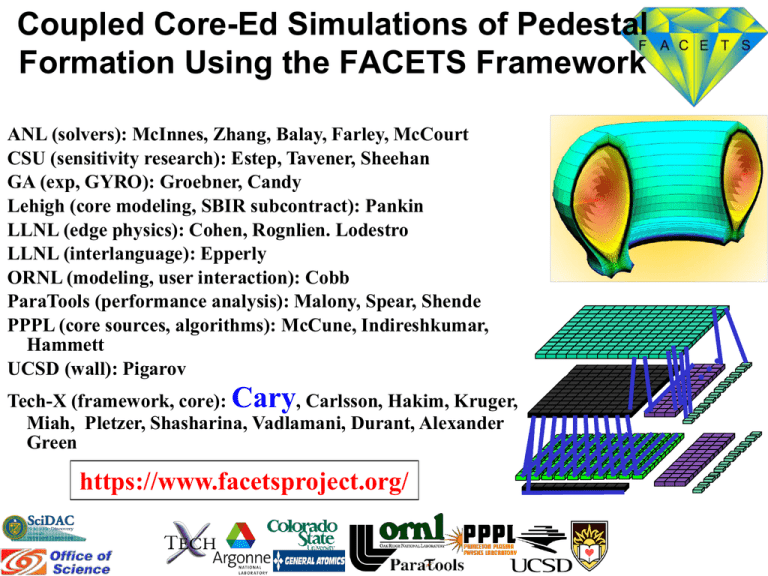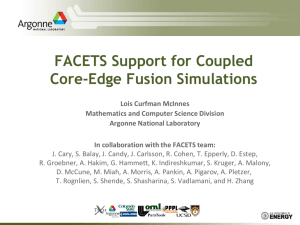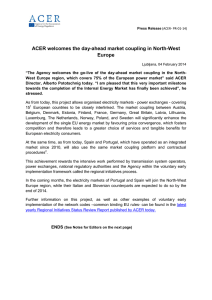framework
advertisement

Coupled Core-Ed Simulations of Pedestal
Formation Using the FACETS Framework
ANL (solvers): McInnes, Zhang, Balay, Farley, McCourt
CSU (sensitivity research): Estep, Tavener, Sheehan
GA (exp, GYRO): Groebner, Candy
Lehigh (core modeling, SBIR subcontract): Pankin
LLNL (edge physics): Cohen, Rognlien. Lodestro
LLNL (interlanguage): Epperly
ORNL (modeling, user interaction): Cobb
ParaTools (performance analysis): Malony, Spear, Shende
PPPL (core sources, algorithms): McCune, Indireshkumar,
Hammett
UCSD (wall): Pigarov
Tech-X (framework, core): Cary, Carlsson, Hakim, Kruger,
Miah, Pletzer, Shasharina, Vadlamani, Durant, Alexander
Green
https://www.facetsproject.org/
FACETS goal: tight coupling framework
for core-edge-wall
Hot central plasma: nearly completely ionized,
magnetic lines lie on flux surfaces, 3D turbulence
embedded in 1D transport
Cooler edge plasma: atomic physics important,
magnetic lines terminate on material surfaces, 3D
turbulence embedded in 2D transport
Material walls, embedded hydrogenic species,
recycling
● Coupling on short time scales
● Implicit coupling
● Inter-processor with MPI and
in-memory communication
2
Tech-X (FACETS Lead Institution):
expertise across computation
● Approx. 70 employees in CO,
CA, NH, NY, GB, CH
● 2/3 PhDs, or about 45
● Computational, computer
science work for DoE, DoD,
NASA, across fusion,
accelerators, space physics,
climate, lunar dust, …
● Work for industrial concerns
(Tokyo Electron, Boeing, LMCO)
● 2004 Dream Beams cover was
the first that was a visualization
of (VORPAL) computationally
generated data
● Computational support for this
year's Excellence in Plasma
Physics Research Award
● China Representative:
Bright-Tech Information
Technology
3
FACETS Approach: couple physics
components
● See next slide for terminology
● A fusion plasma finds a self-consistent, core-edge-wall
state
Energy into the edge determines the pedestal (pressure) height,
while the pedestal height is a dominant determiner of interior
temperature, and so fusion power
Particle recycling involves wall loading/discharging, with the
particles from the wall determining plasma density which then
determines flux into the wall
● Coupling components (as opposed to one monolithic code)
exploits space and time scale disparities and makes use of
proven techniques for incorporating important physics in
each region
● Plus -- it is not possible to cover all scales for all times
(ITER is 20k re across)
4
We do not get hung up over terminology
For us
● Component = unit of software that can model part of the
problem
● Framework: The on-HPC software that couples (primarily)
physics components. FSP has adopted "Physics
Composition Software". From through the queue to queue
job end. "FACETS component", however, obeys the
FACETS component interface.
● Workflow: The software that takes one from concept to
reported result. FSP has adopted "Task Composition
Software"
5
Plasma core: hot, 3D within 1D
● Plasma core is the region well inside
the separatrix
● Transport along field lines >>
perpendicular transport leading to
homogenization in poloidal direction
● 1D core equations in conservative
form:
q = {plasma density, electron energy
density, ion energy density}
F = highly nonlinear fluxes incl.
neoclassical diffusion, electron/ion
temperature gradient induced
turbulence, etc., discussed later
S = particle and heating sources and
sinks
q
F S
t
6
Plasma edge: balance between transport
within and across flux surfaces
● Narrow: strong in-surface transport matched by
slower cross-field transport
● Contacts divertor plates, determines wall loads
● Neutrals transport from edge to fuel core
● First component is UEDGE, multispecies, fluid
plasma transport code
7
The wall is a dynamical medium,
charging, discharging, eroding…
● Challenges
Dynamic and static retention of
hydrogen in walls during and between
the plasma shots
Hydrogen recycling, wall
pumping/outgassing and their effect
on plasma performance
Heat exhaust by wall
Erosion/deposition and wall
components lifetime
● First component: WallPSI
Distinguish mobile, adsorbed and
trapped hydrogen on surfaces and in
the bulk
Wall segment covered with nonuniform mesh with 1 A resolution near
surfaces
8
FACETS addressing a number of
challenges
● Development complexity: FACETS is developing
and/or composing 2.9M lines of code excluding
external libraries
● Social complexity: FACETS researchers and
developers come from a multitude of institutions
with varying cultures about the best way to work
● Fusion community demographics: funding loss in
the 80's and 90's led to a "mature" group, very
much set in their ways. FACETS introduced
subversion, wikis, build systems, metadata, …
9
FACETS factored the problem space
with smaller teams
● Framework, build, testing: Tech-X at
beginning, now additions by LLNL-CS
● Edge modeling: LLNL-FES (physics) with
ANL (applied math) and LLNL-CS (for
making generally available)
● Wall: UCSD, but with Tech-X involvement
● Performance analysis and monitoring
(ParaTools)
● AppMath research (Estep)
● Assistance from
PPPL
on NUBEAM
10
FACETS has made a number of
accomplishments
● Highly portable, robust multi-component "on-HPC"
framework
● Methodology for ensuring robustness
● Verification (cross comparison with ASTRA)
● Implicit, nested iteration core solver, quasi-Newton
core-edge coupling (generic, more than core-edge)
● Componentization of UEDGE, NUBEAM and
WallPSI, GLF23, GYRO, TGLF, NEO, NCLASS
● Robust workflow (multi-platform, multi-parallel
architecture)
● Uniform visualization using standard tools (VisIt,
matplotlib)
● First physics: test of edge predictability
11
Core-Edge-Wall physics requires four
different types of coupling
• Core (1D)/Edge (2D) coupling involves point coupling
• Edge (2D)/Wall (1D) coupling involves point coupling between edge and
multiple wall instances
• Source (2D)/Core(1D) involves volumetric coupling from source to core
• Equilibrium(1D)/Core(1D)/Edge(1D) involves volumetric coupling
Source
Core
w
a
l
l
same points
Coupling
12
FACETS created a recursive communicator
splitting framework for concurrent coupling
FACETS is launched
with a set of available
processor elements
(PEs)
● Core contains
fluxes, sources
● Sources can live
across core and
edge
FACETS allocates PEs
to physics components
fluxes
Edge (e.g.,Uedge)
In this example, the
core divides up PEs
further for flux
calculation
Neutral Beam Sources (NUBEAM)
13
On-HPC "framework" mediates all
communication
WallPSI
UEDGE
Core
NUBEAM
WallPSI
UEDGE
Core
NUBEAM
• Components do not
talk among themselves
• Allows flexible
composition of
components
• Allows generic
coupling schemes to
be written (explicit,
implicit) without
changing component
code
• Frees component
developers from
worrying about every
possible coupling
scenario and scheme
14
New core solver used allows larger
stable time steps
● Core solvers, even
though 1D, are
notoriously difficult
(highly
nonlinear) transport
fluxes as a function
of local values and
gradients
nested iteration
accelerates convergence
"Stiff
very slow convergence,
no nested iteration
2-level nested iteration
accelerates convergence
● Nested iteration
allows large time
steps
15
FACETS core component verified by
comparison with ASTRA
● Benchmark was GLF23
fluxes only for 10 MS
● Ion temperature differs
at r=0.7 by 10%
between ASTRA and
FACETS
● Difference have been
traced to differences in
calculation of
equilibrium quantities.
Ongoing work.
16
Core-edge modeling with interpretive
edge now being done
● Core profiles reasonably well-described by
GLF23 or TGLF
● Edge region lacks predictive models
● Procedure: Use experimental data to
determine coefficients required to give
profiles over 35 msec with just edge region
● Use profiles in fully coupled simulation
● For core region: Turn of GLF23 over a spatial
region to ensure continuity of fluxes
● Sources and impurities come from
interpretive transport simulation
17
Summary and future directions
● A parallel component approach works
well for whole-device modeling including
the edge
● Verification studies have shown ability to
predict pedestal buildup with interpretive
coefficients
Next steps
● Dynamic equilibrium
● Wall
● Predictive edge
18
Extra slides
FACETS now part of the CERF
collaboration: co-design for exascale
BIG
+
small
EXPERIMENT (ITER)
MODELING CODES
Base CPU
Apps
Datapaths
ITERATE
BUILD
Processor
COMPACT APPSGenerator
(Tensilica)
OCD
Cache
Timer
Extended Registers
FPU
CoDEx DESIGN
SKELETON APPS
Application-optimized processor
implementation
PROGRAMMING
MODELS
APPLIED
MATH
20
FACETS strong collaborations have
helped its success
● SWIM collaboration has led to component
improvements that have been exchanged
● PETSc/TOPS collaboration has led to
algorithmic improvements
● VACET collaboration critical to developing
visualization
● Important input from other unfunded
collaborators
Rich
Groebner
Alexei Pankin
21






